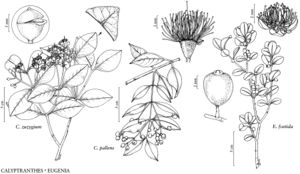Calyptranthes
Prodr., 5, 79. 1788. name conserved
| Taxon | Illustrator ⠉ | |
|---|---|---|
 | Calyptranthes pallens Calyptranthes zuzygium Eugenia foetida |
Shrubs or trees, branching predominantly bifurcate, glabrous or pubescent, hairs simple or dibrachiate. Young stems terete, compressed, or quadrangular, often narrowly 2–keeled to 2–winged, the sharp keels or wings terminating distally between base of petioles. Leaves opposite; blade ± leathery, venation brochidodromous. Inflorescences 9–50+-flowered, subterminal, panicles [rarely spikes], often paired, opposite leaf-axils at proximal node of normal or abortive branch, sometimes subtended by conspicuous, foliaceous bracts, axis usually compressed. Flowers 0–3 (–5) -merous, usually sessile; hypanthium obconic to bowl-shaped, prolonged beyond summit of ovary; calyx closed in bud, forming calyptra, circumscissile, calyptra attached at 1 side in anthesis, usually deciduous; petals 0, 2, or 3 (–5), inconspicuous, white, usually attached to calyptra and falling with it; stamens to ca. 200, filaments white; ovary 2-locular; style linear; stigma punctate; ovules 2 per locule. Fruits berries, bluish black or purplish black, spheroid to oblate, crowned by tubular portion of hypanthium or a circular scar, calyptra remnant occasionally persistent. Seeds 1 or 2, subglobose to oblate; seed-coat papery; cotyledons foliaceous, thin, folded into bundle; hypocotyl elongate, as long as cotyledons and encircling them.
Distribution
Florida, Mexico, West Indies, Bermuda, Central America, South America
Discussion
Species ca. 200 (2 in the flora).
Calyptranthes is an easily identified genus throughout most of its range, though it tends to grade into Marlierea Cambessèdes and Myrcia de Candolle ex Guillemin in Amazonia. The combination of predominantly bifurcate branching and the calyx completely closed in bud and opening circumscissily characterize the genus. Some species have distinctive, narrowly winged or keeled twigs, with the wing/keel in the plane perpendicular to the insertion of the leaves. The inflorescence is usually of paired panicles, but these can be reduced to a few sessile flowers or a spike in some South American species.
Both species of Calyptranthes in Florida are handsome landscape shrubs or small trees for subtropical areas and provide abundant fruit for wildlife.
Selected References
None.
Lower Taxa
Key
| 1 | Inflorescences tomentulose; calyptrae obtuse to rounded; young stems narrowly 2-winged; midvein of leaves sulcate adaxially. | Calyptranthes pallens |
| 1 | Inflorescences glabrous; calyptrae apiculate; young stems terete to compressed (not winged); midvein of leaves convex adaxially. | Calyptranthes zuzygium |